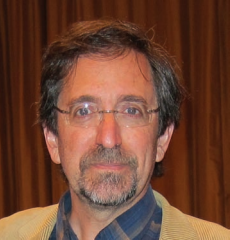
Andrew C Revkin, award-winning Dot Earth Environmental Blogger for The New York Times and former New York Times staff reporter, delivered a lively and compelling keynote address, “The New Science Communication Climate”, at the 2013 CSE annual meeting on 6 May. His talk was a wakeup call to science editors on how to survive and thrive when traditional scientific journalism shrinks and massive amounts of information are at everyone’s fingertips and are creating turmoil for readers who don’t know what information to trust. He made a plea for editors to try to make scientific information useful by clarifying the science and by not overdistilling it. He also encouraged such partnerships as artist–scientist collaborations to convey science in intriguing ways that engage readers.
Revkin acknowledged how hyperlinked we are and noted that many people now just “know” the news through the Web, Facebook, Twitter, or the like and from a multitude of devices. He pointed to a Web site, http://Newsmap.jp, that uses a visualization algorithm to display the most popular Google News stories, which are constantly changing around the world. He stressed that people need to know how to sift out the truth and how to avoid confusion and uncertainty, as occurred with the glut of information and misinformation regarding the 2013 Boston marathon bombing and with the wealth of conflicting information about climate change.
Both a critic and a champion of the scientific communication process, Revkin discussed some pitfalls:
- Science is prone to overinterpretation (for example, genetically modified organisms cause “mortal peril”).
- Science is prone to distortion (for example, the fracking controversy).
- Science can be torqued, or spun, and create reader “whiplash” (for example, studies showing that coffee is good for you or coffee is bad for you).
He presented some “warning labels” for scientific information:
- The single-study syndrome alert. Revkin encouraged fostering the perspective that science is a journey and urged writers to cite previous papers.
- Publicity before publication. Revkin cautioned about publicity for research that occurs before it has been peer reviewed.
- The lure of front-page thought. Is the story really news? Does it justify frontpage treatment? Revkin noted that “funders and reporters have a responsibility in the age of the Insta-net to pause and consider the impact of overstating findings.”
Journal editors also have a responsibility, according to Revkin. Journal abstracts are now immediately public and often posted as news, he said, and this makes it important to state uncertainties and warnings in an abstract itself. Even a simple word choice, like the “Here we show . . .” wording that Revkin said is required in abstracts by Science and Nature, can make findings appear more definitive than they are. “Uncertainty is a form of knowledge,” he stated, and he suggested instead using “Here we explore . . .” or “Here we discuss . . .”.
Revkin also advocated using innovative ways to convey the process of science. He provided some examples:
- “A postcard from the Pleistocene”, http://dotearth.blogs.nytimes.com/2009/07/24/a-postcard-from-the-pleistocene/ on Revkin’s Dot Earth blog, gives a firsthand glimpse into the Polaris Project expedition in Siberia.
- The New York Times Scientist at Work Blog: Notes from the Field, http://scientistatwork.blogs.nytimes.com/, is a modern field journal.
- The National Aeronautics and Space Administration Jet Propulsion Laboratory Twitter feed, @AsteroidWatch, has more than 1 million followers and tracks asteroids and comets.
- #birdclass, an ornithology course feed about bird sightings and behavior; #wjchat for Web journalists; #scicomm for science communication; and #paceblog, Revkin’s Pace University class blog.
Although he said that the examples above are a “great way to use tools we are just scratching the surface of”, he also provided examples of new ways to look at data:
- The New England Journal of Medicine’s dynamic graphic representation of obesity in large social networks, http://www.nejm.org/doi/full/10.1056/NEJMsa066082.1
- A striking illustration of global water and air volume, http://www.sciencephoto.com/media/159214/view.
Revkin concluded by saying that “how we present data is the biggest area for breakthroughs” and he wonders if there are business models for data presentation. He encouraged partnerships, collaboration, and cross-talk among videographers, artists, and scientists.
- The Spread of Obesity in a Large Social Network over 32 Years. N Engl J Med. 2007 Jul 26;357(4):370–9. Epub 2007 Jul 25.
